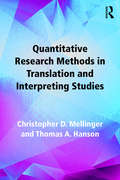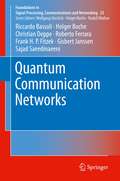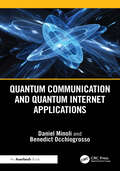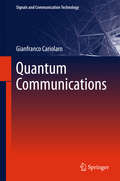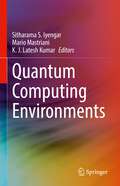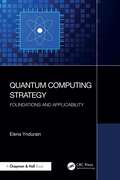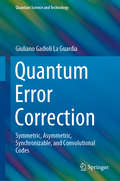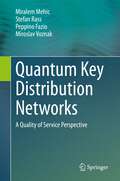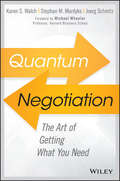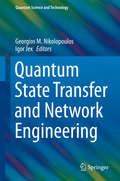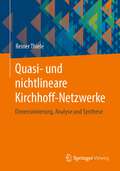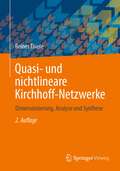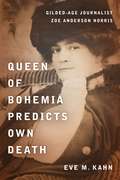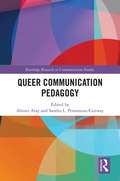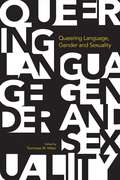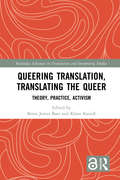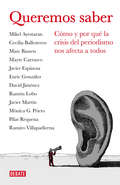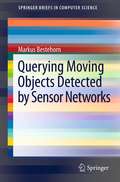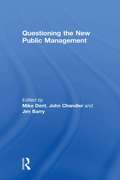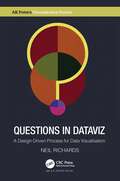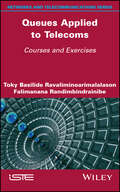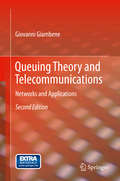- Table View
- List View
Quantitative Research Methods in Translation and Interpreting Studies
by Christopher Mellinger Thomas A. HansonQuantitative Research Methods in Translation and Interpreting Studies encompasses all stages of the research process that include quantitative research methods, from conceptualization to reporting. In five parts, the authors cover: • sampling techniques, measurement, and survey design; • how to describe data; • how to analyze differences; • how to analyze relationships; • how to interpret results. Each part includes references to additional resources and extensive examples from published empirical work. A quick reference table for specific tests is also included in the appendix. This user-friendly guide is the essential primer on quantitative methods for all students and researchers in translation and interpreting studies. Accompanying materials are available online, including step-by-step walkthroughs of how analysis was conducted, and extra sample data sets for instruction and self study: https://www.routledge.com/9781138124967. Further resources for Translation and Interpreting Studies are available on the Routledge Translation Studies Portal: http://cw.routledge.com/textbooks/translationstudies.
Quantum Communication Networks (Foundations in Signal Processing, Communications and Networking #23)
by Frank H. Fitzek Holger Boche Christian Deppe Riccardo Bassoli Roberto Ferrara Gisbert Janssen Sajad SaeedinaeeniThis book provides a tutorial on quantum communication networks. The authors discuss current paradigm shifts in communication networks that are needed to add computing and storage to the simple transport ideas of prevailing networks. They show how these ‘softwarized’ solutions break new grounds to reduce latency and increase resilience. The authors discuss how even though these solutions have inherent problems due to introduced computing latency and energy consumption, the problems can be solved by hybrid classical-quantum communication networks. The book brings together quantum networking, quantum information theory, quantum computing, and quantum simulation.
Quantum Communication and Quantum Internet Applications
by Daniel Minoli Benedict OcchiogrossoQuantum computing, particularly in conjunction with a high level of interconnectivity facilitated by quantum connectivity, can facilitate a host of new, previously unattainable applications—these include blind quantum computation, (information) teleporting, clock synchronization, quantum key distribution, secure access to remote quantum computers, superdense coding, secure identification, quantum-secure encryption, distributed sensors, and other scientific and commercial applications, including new drug development.Quantum Communication and Quantum Internet Applications is a basic introduction to quantum computing and presents the emerging foundations of quantum communications and applications. Written for telecommunications professionals, the book explains basic principles of quantum mechanics and strives to make quantum science accessible with a minimal mathematical investment. This book is a point of departure into the application of quantum computing and mechanics to communications. Features include: An introductory overview of quantum communications Basic and advanced mathematical concepts in quantum physics Basic physical technologies An overview of quantum computers and their role as nodes in the quantum internet (i.e., the Quaint) Quantum communications, including logical architectures and the Quaint Quantum-based security Software tools to develop networked quantum applications. Glossaries of terms and concepts. The book synthetizes background material on quantum computing so that telecom managers and other telecom professionals can get a basic understanding of this fast-emerging computing discipline and its application to telecom. It is a guide to the newly emerging fields of quantum communications, quantum internet, remote connectivity, and networking.
Quantum Communications
by Gianfranco CariolaroThis book demonstrates that a quantum communication system using the coherent light of a laser can achieve performance orders of magnitude superior to classical optical communications Quantum Communications provides the Masters and PhD signals or communications student with a complete basics-to-applications course in using the principles of quantum mechanics to provide cutting-edge telecommunications. Assuming only knowledge of elementary probability, complex analysis and optics, the book guides its reader through the fundamentals of vector and Hilbert spaces and the necessary quantum-mechanical ideas, simply formulated in four postulates. A turn to practical matters begins with and is then developed by: · development of the concept of quantum decision, emphasizing the optimization of measurements to extract useful information from a quantum system; · general formulation of a transmitter-receiver system · particular treatment of the most popular quantum communications systems--OOK, PPM, PSK and QAM; · more realistic performance evaluation introducing thermal noise and system description with density operators; · consideration of scarce existing implementations of quantum communications systems and their difficulties with suggestions for future improvement; and · separate treatment of quantum information with discrete and continuous states. Quantum Communications develops the engineering student's exposure to quantum mechanics and shows physics students that its theories can have practically beneficial application in communications systems. The use of example and exercise questions (together with a downloadable solutions manual for instructors) will help to make the material presented really sink in for students and invigorate subsequent research.
Quantum Computing Environments
by Sitharama S. Iyengar Mario Mastriani K. J. Latesh KumarThis book explains the evolution of techniques and strategies in quantum computing, discussing the digital transition towards the quantum computing application in various sectors. The book provides a comprehensive insight into the quantum mechanics and quantum computing techniques and tools and how they have evolved and the impacted in supporting and flourishing business during the quantum computing era. This book includes chapters that discuss the most primitive quantum schemes to the most recent use of Internet, finance and radar technology, thus leveraging greater use of new technologies like security and Internet and others. The content is relevant for an audience that is involved in the research and development of advanced quantum systems. It gives the industry, researchers, and students interested in learning the various quantum computing sectors with the necessary information and tools that can be used to research, design and develop advanced quantum computing systems and techniques.
Quantum Computing Strategy: Foundations and Applicability
by Elena YndurainQuantum computing is not merely an incremental advancement in computing technology; it represents a fundamentally new paradigm, distinct from classical computing. Rooted in quantum mechanics, it introduces an entirely novel information theory. As a result, translating existing models, solution designs, and approaches to quantum computing is a complex, non-trivial task. This comprehensive book demystifies quantum concepts through accessible explanations, practical case studies, and real-world examples from industries such as aerospace, agriculture, automotive, chemicals, energy, finance, government, healthcare, manufacturing, supply chain, and telecommunications.Blending a business perspective with a scientific rigor, this book is divided into two parts. The first part covers foundational technical concepts, including quantum mechanics principles that enable quantum technologies, key quantum algorithms, mathematical frameworks, quantum computing technologies, post-quantum cryptography, the types of problems quantum computers solve, and the technology’s outlook. The second part focuses on practical applicability, presenting industry use cases, guidance on approaching quantum computing problems, mapping use cases to quantum computing, responsible quantum computing practices, and a roadmap for businesses preparing for quantum adoption. This structured approach equips readers with the knowledge and tools to effectively integrate quantum computing into their strategic planning.Quantum Computing Strategy: Foundations and Applicability serves as an essential reference for technology enthusiasts, business leaders, policymakers, and educators seeking to understand the benefits quantum computing offers enterprises. Designed as a self-contained learning resource, it empowers readers to navigate the emerging quantum landscape confidently.
Quantum Error Correction: Symmetric, Asymmetric, Synchronizable, and Convolutional Codes (Quantum Science and Technology)
by Giuliano Gadioli La GuardiaThis text presents an algebraic approach to the construction of several important families of quantum codes derived from classical codes by applying the well-known Calderbank-Shor-Steane (CSS), Hermitian, and Steane enlargement constructions to certain classes of classical codes. In addition, the book presents families of asymmetric quantum codes with good parameters and provides a detailed description of the procedures adopted to construct families of asymmetric quantum convolutional codes.Featuring accessible language and clear explanations, the book is suitable for use in advanced undergraduate and graduate courses as well as for self-guided study and reference. It provides an expert introduction to algebraic techniques of code construction and, because all of the constructions are performed algebraically, it enables the reader to construct families of codes, rather than only codes with specific parameters. The text offers an abundance of worked examples, exercises, and open-ended problems to motivate the reader to further investigate this rich area of inquiry. End-of-chapter summaries and a glossary of key terms allow for easy review and reference.
Quantum Key Distribution Networks: A Quality of Service Perspective
by Stefan Rass Miralem Mehic Peppino Fazio Miroslav VoznakThis book focuses on practical implementation details, telecommunication techniques, security and technology challenges and approaches to implementing quantum technology in modern telecommunication systems. The authors use their extensive practical academic and industrial experience in network technologies and provide details from international projects in quantum cryptography in which they actively participate. Using a variety of examples, analogies, illustrations, tables, and features from practical quantum network realizations, the authors provide a unique view of quantum technology from an engineering telecommunication standpoint, allowing the reader to identify the advantages and challenges of quantum technology.This book also addresses challenges posed by quantum technology such as network organization, passive and active eavesdropping, and future trends in QKD such as Software Defined Networking (SDN) with QKD and application QKD in 5G networks. It is conceived through eight chapters by treating the following thematic units separately: Fundamentals of Quantum Key Distribution, QoS architecture/mode, QoS MAC layer, QoS signaling techniques for key management and session negotiation purpose and QoS routing protocols that minimize the consumption of key material through the equitable utilization of network resources when finding an optimal path. Through numerous information on practical solutions, simulation examples, illustrations, and analysis, readers can easily distinguish the specificity of quantum technology and understand the challenges and methods of practical implementation of quantum cryptography in common telecommunications standards. Researchers working in quantum technology and applied networking security as well as advanced-level students studying computer science and electrical engineering will benefit from this book. Professionals working within these related fields will also benefit from this book.
Quantum Negotiation: The Art of Getting What You Need
by Michael Wheeler Joerg Schmitz Stephan M. Mardyks Karen S. WalchMaster the art of getting what you need with a more collaborative approach to negotiation Quantum Negotiation is a handbook for getting what you need using a mindset and behaviors based on a refreshingly expansive perspective on negotiation. Rather that viewing every negotiation as an antagonistic and combative relationship, this book shows you how to move beyond the traditional pseudo win-win to construct a deal in which all parties get what they need. By exploring who we are as negotiators in the context of social conditioning, this model examines the cognitive, psychological, social, physical, and spiritual aspects of negotiation to help you produce more sustainable, prosperous, and satisfying agreements. We often think of negotiation as taking place in a boardroom, a car dealership, or any other contract-centered situation; in reality, we are negotiating every time we ask for something we need or want. Building more robust negotiation behaviors that resonate beyond the boardroom requires a deep engagement with others and a clear mindset of interdependence. This book helps you shift your perspective and build these important skills through a journey of discovery, reflection, and action. Rethink your assumptions about negotiations, your self-perception, your counterpart, and the overall relationship Adopt new tools that clarify what you want, why you need it, and how your counterpart can also get what they want and need Challenge fundamental world views related to negotiation, and shift from adversarial to engaging and satisfying Understand the unseen forces at work in any negotiation, and prevent them from derailing your success In the interest of creating an environment that elevates everyone’s participation and assists them in reaching their full potential, Quantum Negotiation addresses the reality of hardball and coercion with a focus on engaging the human spirit to create new opportunities and resources.
Quantum State Transfer and Network Engineering
by Georgios M. Nikolopoulos Igor JexFaithful communication is a necessary precondition for large-scale quantum information processing and networking, irrespective of the physical platform. Thus, the problems of quantum-state transfer and quantum-network engineering have attracted enormous interest over the last years, and constitute one of the most active areas of research in quantum information processing. The present volume introduces the reader to fundamental concepts and various aspects of this exciting research area, including links to other related areas and problems. The implementation of state-transfer schemes and the engineering of quantum networks are discussed in the framework of various quantum optical and condensed matter systems, emphasizing the interdisciplinary character of the research area. Each chapter is a review of theoretical or experimental achievements on a particular topic, written by leading scientists in the field. The volume aims at both newcomers as well as experienced researchers.
Quantum-Dot-Based Semiconductor Optical Amplifiers for O-Band Optical Communication
by Holger SchmeckebierThis thesis examines the unique properties of gallium arsenide (GaAs)-based quantum-dot semiconductor optical amplifiers for optical communication networks, introducing readers to their fundamentals, basic parameters and manifold applications. The static and dynamic properties of these amplifiers are discussed extensively in comparison to conventional, non quantum-dot based amplifiers, and their unique advantages are elaborated on, such as the fast carrier dynamics and the decoupling of gain and phase dynamics. In addition to diverse amplification scenarios involving single and multiple high symbol rate amplitude and phase-coded data signals, wide-range wavelength conversion as a key functionality for optical signal processing is investigated and discussed in detail. Furthermore, two novel device concepts are developed and demonstrated that have the potential to significantly simplify network architectures, reducing the investment and maintenance costs as well as the energy consumption of future networks.
Quasi- und nichtlineare Kirchhoff-Netzwerke: Dimensionierung, Analyse und Synthese
by Reiner ThieleDas Buch vermittelt neuartige Analyse- und Syntheseverfahren für quasi- und nichtlineare Kirchhoff-Netzwerke. Hierzu verwendet der Autor als Unternetzwerke gewöhnliche Widerstände, Kondensatoren, Spulen, Übertrager, Transistoren oder Dioden sowie die sogenannten pathologischen Unternetzwerke Nullator und Norator. Zur Analyse oder Synthese erfolgt eine Zerlegung der Gleichungen zur Beschreibung des Klemmenverhaltens in die u-i-Relationen realisierbarer Unternetzwerke sowie in Strukturgleichungen nach Kirchhoff. Dazu kreiert Reiner Thiele neue nichtlineare Transistor- bzw. Dioden-Modelle. Außerdem zeigt er, wie durch die Applikation von Klemmen-Äquivalenzen praxisrelevante elektrische oder elektronische Schaltungen entstehen.
Quasi- und nichtlineare Kirchhoff-Netzwerke: Dimensionierung, Analyse und Synthese
by Reiner ThieleDas Buch vermittelt neuartige Analyse- und Syntheseverfahren für quasi- und nichtlineare Kirchhoff-Netzwerke. Hierzu verwendet der Autor als Unternetzwerke gewöhnliche Widerstände, Kondensatoren, Spulen, Übertrager, Transistoren oder Dioden sowie die sogenannten pathologischen Unternetzwerke Nullator und Norator. Zur Analyse oder Synthese erfolgt eine Zerlegung der Gleichungen zur Beschreibung des Klemmenverhaltens in die u-i-Relationen realisierbarer Unternetzwerke sowie in Strukturgleichungen nach Kirchhoff. Dazu kreiert Reiner Thiele neue nichtlineare Transistor- bzw. Dioden-Modelle. Außerdem zeigt er, wie durch die Applikation von Klemmen-Äquivalenzen praxisrelevante elektrische oder elektronische Schaltungen entstehen.
Queen of Bohemia Predicts Own Death: Gilded-Age Journalist Zoe Anderson Norris
by Eve M. KahnA trailblazing journalist who took on New York’s Gilded-Age injustices Zoe Anderson Norris was a woman ahead of her time. A Kentucky-born belle turned fearless Manhattan journalist, she used her pen as a weapon in the fight for justice. From exposing slumlords and corrupt politicians to advocating for impoverished immigrants, she captured the injustices of her era with a wit and tenacity that still resonate today. In this first biography of Norris, independent scholar Eve Kahn restores her legacy, illuminating her work as a novelist, magazine publisher, and social reformer who challenged the powerful and gave voice to the oppressed. A prolific writer and editor, Norris chronicled the struggles of Lower East Side immigrants in her self-published periodical, The East Side, often going undercover to report on the harsh realities of tenement life. She documented tragedies such as the Triangle Shirtwaist Factory Fire, publicly denounced predatory men, and advised women on seizing control of their destinies. With her bohemian spirit, she led the Ragged Edge Klub, a gathering of artists, writers, and social critics who rejected the status quo. But Norris’s courage came at a personal cost. Her life was marked by tumultuous relationships, family estrangement, and battles against the very injustices she exposed. She endured financial struggles, unfaithful or deadbeat husbands, and social ostracization for her refusal to remain silent. In her final issue of The East Side, she eerily predicted her own death, an uncanny premonition that made national headlines before she faded into obscurity. With meticulous research and captivating storytelling, Kahn brings Norris’s extraordinary life back into the spotlight. Drawing on newly uncovered archival materials, including Norris’s own writings, letters, and investigative reports, Queen of Bohemia Predicts Own Death sheds light on a fearless journalist whose influence on investigative reporting and social justice continues to be felt today. This biography is a compelling testament to the power of the written word in the fight for truth and equity.
Queer Communication Pedagogy (Routledge Research in Communication Studies)
by Ahmet Atay Sandra L. Pensoneau-ConwayThis book addresses queer issues and current events from a communication perspective to articulate a queer communication pedagogy. Through putting communication pedagogy and queer studies into dialogue, the book investigates how queer theory and critical communication pedagogy intersect in pedagogical spaces. The chapters identify institutional and educational barriers, oppressions, and issues pertaining to queer lives in the context of higher education. Using a variety of critical methodological approaches (including dialogic methods, autoethnography, performative writing, and visual methods), each chapter theorizes a queer communication pedagogy, and offers a path toward and innovative ideas about materializing queer communication pedagogy as a disciplinary endeavor. This book will be of interest to scholars, graduate students, and upper-level undergraduate students in Communication Studies, Critical Communication Pedagogy, Intercultural Communication, Higher Education, Public Pedagogy, and Queer Studies, and Critical/Cultural Studies.
Queering Language: Gender and Sexuality
by Tommaso M. MilaniThis volume showcases ten years of research on language, gender and sexuality informed by queer theory. In line with a queer dislike for any normalizing discourse and practice, the book gives a multi-faceted set of applications of queer theoretical ideas to linguistic analysis.
Queering Translation, Translating the Queer: Theory, Practice, Activism (Routledge Advances in Translation and Interpreting Studies)
by Brian James Baer Klaus KaindlThis groundbreaking work is the first full book-length publication to critically engage in the emerging field of research on the queer aspects of translation and interpreting studies. The volume presents a variety of theoretical and disciplinary perspectives through fifteen contributions from both established and up-and-coming scholars in the field to demonstrate the interconnectedness between translation and queer aspects of sex, gender, and identity. The book begins with the editors’ introduction to the state of the field, providing an overview of both current and developing lines of research, and builds on this foundation to look at this research more closely, grouped around three different sections: Queer Theorizing of Translation; Case Studies of Queer Translations and Translators; and Queer Activism and Translation. This interdisciplinary approach seeks to not only shed light on this promising field of research but also to promote cross fertilization between these disciplines towards further exploring the intersections between queer studies and translation studies, making this volume key reading for students and scholars interested in translation studies, queer studies, politics, and activism, and gender and sexuality studies.
Queerstories: Reflections on lives well lived from some of Australia's finest LGBTQIA+ writers
by Maeve MarsdenThere's more to being queer than coming out and getting married. This exciting and contemporary collection contains stories that are as diverse as the LGBTQIA+ community from which they're drawn. From hilarious anecdotes of an awkward adolescence, to heartwarming stories of family acceptance and self-discovery, the LGBTQIA+ community has been sharing stories for centuries, creating their own histories, disrupting and reinventing conventional ideas about narrative, family, love and community.Curated from the hugely popular Queerstories storytelling event this important collection features stories from Benjamin Law, Jen Cloher, Nayuka Gorrie, Peter Polites, Candy Royalle, Rebecca Shaw, Simon 'Pauline Pantsdown' Hunt, Steven Lindsay Ross, Amy Coopes, Paul van Reyk, Mama Alto, Liz Duck-Chong, Maxine Kauter, David Cunningham, Peter Taggart, Ben McLeay, Jax Jacki Brown, Ginger Valentine, Candy Bowers, Simon Copland, Kelly Azizi, Nic Holas, Quinn Eades, Vicki Melson, Tim Bishop and Maeve Marsden.
Queremos saber: Cómo y por qué la crisis del periodismo nos afecta a todos (Libros para entender la crisis #Volumen)
by Varios AutoresEn Queremos saber, doce periodistas de una amplia trayectoria internacional reflexionan sobre la crisis que está atravesando el periodismo y explican las nefastas consecuencias que eso tiene para el correcto funcionamiento de una democracia. La crisis económica general ha coincidido en el tiempo con una crisis propia de los medios de comunicación y por tanto del periodismo, obligado a adaptarse a la nueva realidad digital. Como en toda crisis, se corre el riesgo de recortar cosas fundamentales, y conservar otras accesorias: suprimir lo más caro, no lo menos necesario. En un medio lo más caro es la información internacional propia de calidad, por eso en esa sección se pueden ver aumentados los problemas y los desafíos del periodismo. Reseñas:«No recuerdo cuándo, exactamente, explicar en la redacción la importancia de la historia vivida, relatada en forma de reportaje, se convirtió en una tarea más ardua que atravesar fronteras, esquivar ataques, granjearse la confianza de combatientes y civiles, y superar el miedo para convertirse así en testigo directo de los hechos. En mi opinión, eso marca el momento de la crisis existencial del periodismo.»Mónica G. Prieto «Hoy más que nunca los periódicos deberían apostar por las historias propias, los reportajes, y olvidarse de un concepto que sí que se ha quedado anticuado debido a internet, la noticia de ayer.»Javier Espinosa «El corresponsal ha dejado de tener sentido si no es para ofrecer profundidad frente a la inmediatez, precisión frente a la falta de rigor, reporterismo literario frente a la escritura urgente y originalidad frente al rebaño que hemos formado los medios de comunicación.»David Jiménez «El buen periodismo seguirá siendo propiedad de los buenos periodistas, de aquellos que prefieran formular preguntas incómodas a escribir al dictado, que indaguen en el origen, buceen en las causas y sepanleer entre líneas, sin importar el tipo de plataforma que se utilice.»Javier Martín «Si renunciamos a enviar periodistas a los sitios, no ya a Afganistán, sino a la calle de enfrente; si creemos que una pantalla de ordenador o de una tableta, por muy HD y táctil que sea, puede reemplazar el olor, el color, el miedo, la soledad, las voces y sus silencios, habremos matado el reportaje y el periodismo. Seremos innecesarios, sólo puro entretenimiento.»Ramón Lobo «Pese a la efervescencia de internet, son los medios poderosos los que deciden de qué se habla y de qué no. [...] Cualquier guerra, cualquier genocidio, es peor cuando falta información.»Enric González
Querying Moving Objects Detected by Sensor Networks
by Markus BestehornDeclarative query interfaces to Sensor Networks (SN) have become a commodity. These interfaces allow access to SN deployed for collecting data using relational queries. However, SN are not confined to data collection, but may track object movement, e.g., wildlife observation or traffic monitoring. While rational approaches are well suited for data collection, research on Moving Object Databases (MOD) has shown that relational operators are unsuitable to express information needs on object movement, i.e., spatio-temporal queries. Querying Moving Objects Detected by Sensor Networks studies declarative access to SN that track moving objects. The properties of SN present a straightforward application of MOD, e.g., node failures, limited detection ranges and accuracy which vary over time etc. Furthermore, point sets used to model MOD-entities like regions assume the availability of very accurate knowledge regarding the spatial extend of these entities, assuming such knowledge is unrealistic for most SN. This book is the first that defines a complete set of spatio-temporal operators for SN while taking into account their properties. Based on these operators, we systematically investigate how to derive query results from object detections by SN. Finally, process spatio-temporal queries are shown in SN efficiently, i.e., reducing the communication between nodes. The evaluation shows that the measures reduce communication by 45%-89%.
Questioning the New Public Management
by John ChandlerThe book contains a wealth of detailed and fascinating case studies of New Public Management (NPM) in practice in the UK, exploring the enactment of NPM in its specific organizational contexts. A range of public services are covered including local government, education, social work and the police, with particular attention paid to the National Health Service. The editors introduce the case studies through an examination of the 'hydra-headed' nature of NPM, its variability between sectors and its contested character. This provides themes that are developed within the case studies, where, in varying organizational contexts, the meaning of NPM is negotiated and its impact on those working in the organization is explored. The book points to the complex, fluid and negotiated character of NPM, as well as its centrality in reconfiguring occupational identities and relations within public service organizations.
Questions in Dataviz: A Design-Driven Process for Data Visualisation (AK Peters Visualization Series)
by Neil RichardsThis book takes the reader through the process of learning and creating data visualisation, following a unique journey with questions every step of the way, ultimately discussing how and when to bend and break the "rules" to come up with creative, unique, and sometimes unconventional ideas. Each easy-to-follow chapter poses one key question and provides a selection of discussion points and relevant data visualisation examples throughout. Structured in three parts: Section I poses questions around some fundamental data visualisation principles, while Section II introduces more advanced questions, challenging perceived best practices and suggesting when rules are open to interpretation or there to be broken. The questions in Section III introduce further themes leading on to specific ideas and visualisation projects in more detail. Questions in Dataviz: A Design-Driven Process for Data Visualisation will appeal to any reader with an interest in creative or unconventional data visualisation and will be especially useful for those at a beginner or intermediate level looking for inspiration and alternative ways to deploy their data visualisation skills outside of conventional business charts.
Queues Applied to Telecoms: Courses and Exercises
by Toky Basilide Ravaliminoarimalalason Falimanana Randimbindrainibe<p> From queues to telecoms. Queues are, of course, omnipresent in our world, at the bank, the supermarket, the shops, on the road... and yes, they also exist in the domain of telecoms. <p> <p> Queues Applied to Telecoms studies the theoretical aspect of these queues, from Poisson processes, Markov chains and queueing systems to queueing networks. The study of the use of their resources is addressed by the theory of teletraffic. This book also outlines the basic ideas in the theory of teletraffic, presenting the teletraffic of loss systems and waiting systems. <p> <p> However, some applications and explanations are more oriented towards the field of telecommunications, and this book contains lectures and more than sixty corrected exercises to cover these topics. On your marks....<p>
Queuing Theory and Telecommunications
by Giovanni GiambeneThis book is aimed to provide a basic description of current networking technologies and protocols as well as to provide important tools for network performance analysis based on queuing theory. The second edition adds selected contents in the first part of the book for what concerns: (i) the token bucket regulator and traffic shaping issues; (ii) the TCP protocol congestion control that has a significant part in current networking; (iii) basic satellite networking issues; (iv) adding details on QoS support in IP networks. The book is organized so that we have first networking technologies and protocols (Part I) and then theory and exercises with applications to the different technologies and protocols (Part II). This book is intended as a textbook for master level courses in networking and telecommunications sectors.
Queuing Theory and Telecommunications: Networks and Applications (Textbooks in Telecommunication Engineering)
by Giovanni GiambeneThis thoroughly revised textbook provides a description of current networking technologies and protocols as well as important new tools for network performance analysis based on queuing theory. The third edition adds topics such as network virtualization and new related architectures, novel satellite systems (such as Space X, OneWeb), jitter and its impact on streaming services, packet level FEC techniques and network coding, new Markovian models, and advanced details on M/G/1 queuing models. The author also adds new selected exercises throughout the chapters and a new version of the slides and the solution manual. The book maintains its organization with networking technologies and protocols in Part I and then theory and exercises with applications to the different technologies and protocols in Part II. This book is intended as a textbook for master level courses in networking and telecommunications sectors.
